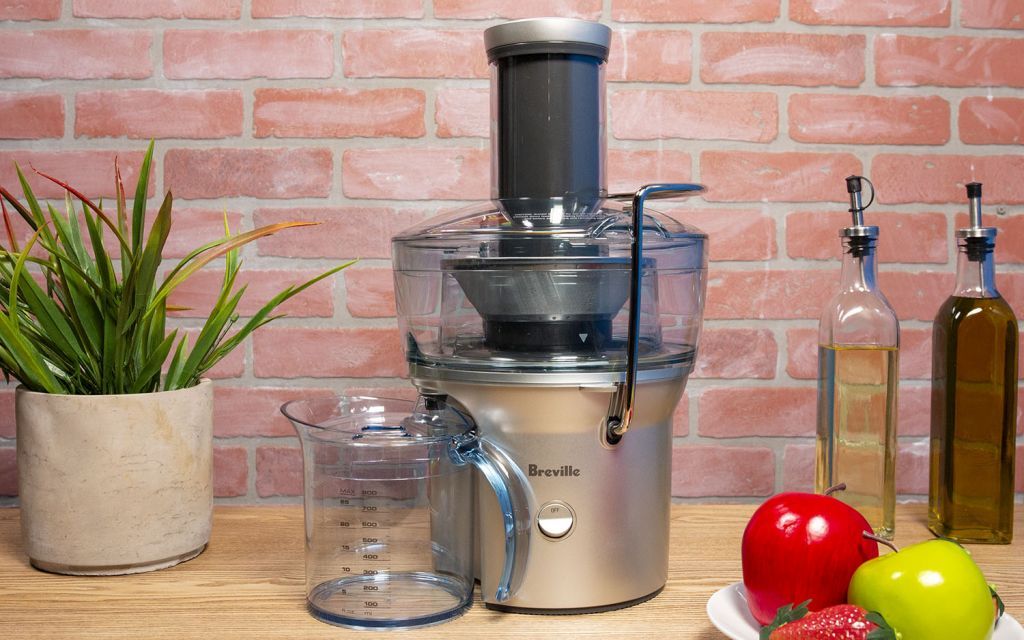It’s estimated that approximately
90% of people
Trusted Source
Fruits and Vegetables: 90% of Americans Don't Eat Enough | Time
The vast majority of Americans are not eating enough fruits and vegetables, according to a new report from the CDC.
time.com
don’t consume sufficient fruit and vegetables. Many people don’t eat enough fruits and vegetables for a variety of reasons but it is often easier to get them to drink juices instead. When we juice our fruits and vegetables we can pack a lot of nutrients into a single drink making it a convenient option. For this reason, juicing has grown in popularity over the last decade and many people want their own juicer at home. Most modern juicers have an electric motor and they extract the juice from the fruits and vegetables to remove the pulp. There are different types of juicers, pros and cons to consider and it can be hard to choose the right one to meet your needs. In this article we will take a closer look at the different types of juicers on the market today to help you choose the right one to meet your needs.
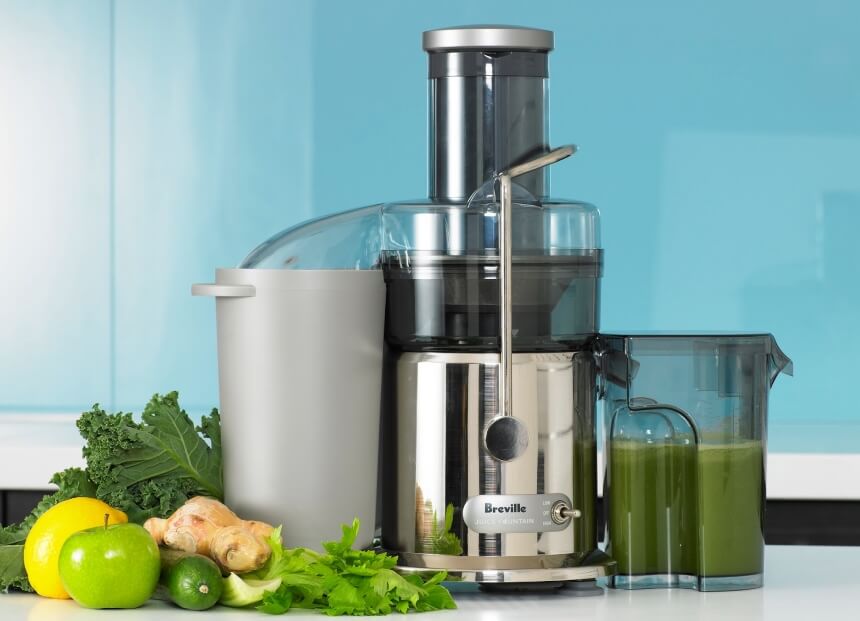
The spinning blade in a centrifugal juicer makes short work of harder fruits and vegetables such as apples, celery and carrots. The feeding chute needs to be wide enough to feed easily but most models require some cutting into smaller chunks to reduce stress on the juicer motor. More expensive models with powerful motors may allow you to feed in an entire piece of fruit or a vegetable in a single action. A centrifugal juicer can also handle softer fruits and they are a practical way to produce a single glass of juice.
Because centrifugal juicers tend to be inexpensive they are a popular choice for people new to juicing. This type of juice stands upright and it takes up less space on the countertop when juicing. They are easy to use, they have fewer parts and the best models can be cleaned in the dishwasher. But, there are some downsides to this type of juicer, they can be noisy to use and they produce foam. This foam is created when air is trapped in the juice by the action of the shredding blade.
Another major problem is oxidation, this is what happens when you cut fruits or vegetables with a blade and they turn brown. When you use a centrifugal juicer the blade is cutting the fruit continuously at a high rate of speed. This causes the juice to be oxidized rapidly during the extraction and many nutrients are lost during the process. Centrifugal juicers are a quick and easy way to extract juice but the quality is not as good as other types of juicing methods.

A masticating juicer chews at the fruits and vegetables to extract the maximum volume of juice creating a fine pulp. This masticating process releases far more nutrients and enzymes into the juice than you would get from a centrifugal juicer. The juice will typically have a deeper color and be far healthier to drink.
A masticating juicer operates slowly at around 80-120 rpm and this reduces the oxidation significantly. When a centrifugal blade spins it generates heat that can destroy the antioxidants and enzymes that you want in your juices. Because a masticating juicer is efficient it can handle wheatgrass, herbs, leafy vegetables and softer fruits. Many people are surprised when they use a masticating juicer for the first time because the pulp is very dry. This is because masticating juicers have a very good rate of juice extraction making them an efficient juicing method.
This is a versatile type of kitchen machine and many people use them as a grinder or food processor. The best masticating juicers can perform tasks, such as: blending baby food, making peanut butter and even grinding coffee beans. Some manufacturers include extra attachments with their machines that allow the user to make crushed coffee bean desserts and fruit sorbets. There are two main types of masticating juicers, they are: vertical and horizontal and both have their own advantages and disadvantages to consider.
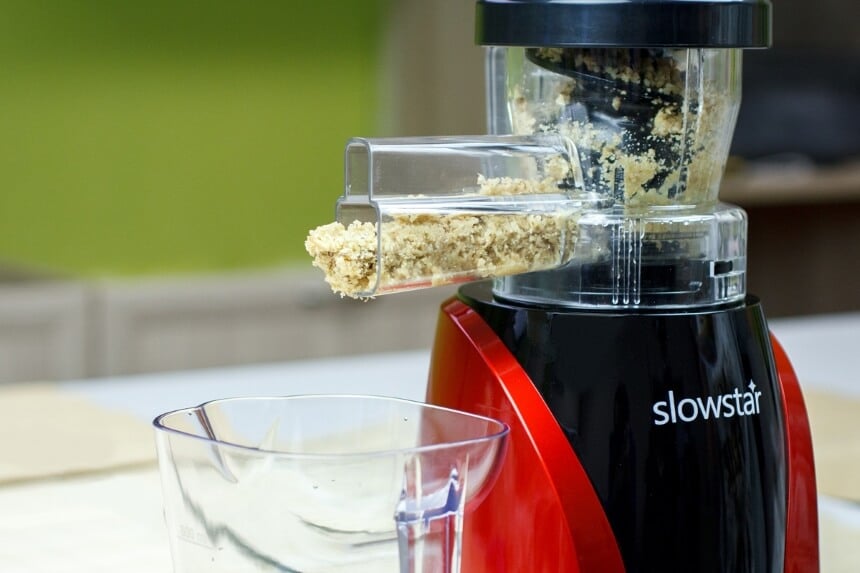
One of the best things about a vertical masticating juicer is that it doesn’t take up too much countertop space. The best new models such as the Tribest SW-2000 Slowstar have a mincing attachment that makes the machine versatile. This type of machine typically has some added features such as self cleaning and a wide feeding tube. This makes this type of machine a great option if you want minimal prep work and you don’t want to chop up fruits and vegetables before juicing.
When most people think of a masticating juicer they are imagining a horizontal orientation. A horizontal model such as the Omega NC900HDC Juicer Extractor and Nutrition System is the ideal machine to extract juice from leafy greens and wheatgrass. When you use a masticating juicer less pre-cutting is required and clogging is not a problem. Like the vertical units these types of juicers are often supplied with extra attachments to increase the utility of the machine. This could include extra meshes that allow the user to make sorbets and smooth sauces for cooking.
A horizontal masticating juicer will have a smaller feed chute and some pre-cutting may be required. Because this type of machine takes up more counter space plus a cutting board for the fruit or vegetables you will need a lot of space for juicing. But, the operation of masticating juicers is quiet and they do produce high quality juices that are packed with nutrients, antioxidants and enzymes. The juice yield is high and the amount of generated pulp is extremely dry. This type of juicer has more pàrts and cleaning can be a hassle but if you want the best juice and you don’t mind a short wait they are hard to beat.
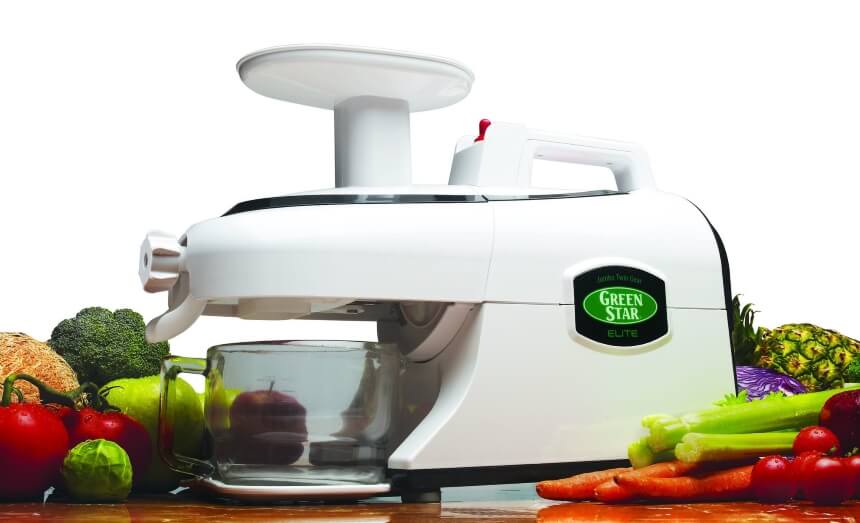
One of the main advantages of a twin-gear juicer is that it can perform a great job at extracting juice from fruits, wheatgrass and leafy greens. These types of juicers work slowly, as an example: the Tribest GSE-5000 Cold Press Complete Masticating Slow Juicer works at just 100 rpm. However, the high torque means that this machine can juice harder fruits and vegetables efficiently if you don’t mind waiting for your juice.
A triturating juicer has more parts than other juicers featured in this article. As you might imagine this makes assembly and cleaning a time consuming chore and you need to be methodical to avoid misplacing parts. On the positive side, these are self feeding machines due to the gear motion and you can even make pasta or grind grains with the right attachments.
A twin-gear juicer will extract juice efficiently from many fruits and vegetables but it’s less efficient with softer fruits. If you want to juice oranges and pineapples this is not an ideal juicing method because they don’t have a lot of pulp which the augurs need to push the food when juicing.
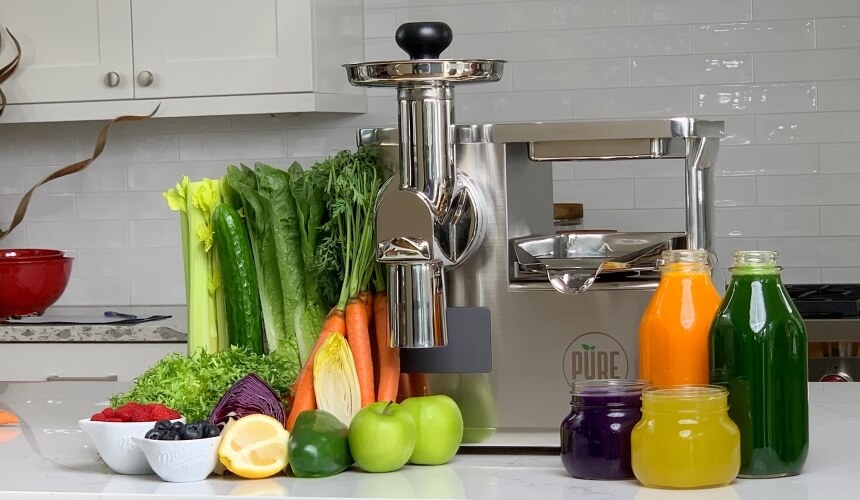
Next to no oxidation takes place when using a hydraulic press juicer which means that you don’t need to drink the juice immediately. In fact, this type of juicing method creates a fresh juice that has the longest shelf life of 3-5 days. The juice is extracted under thousands of pounds of applied pressure per square inch. Minimal heat is generated during the juice extraction and this means that the enzymes, minerals and vitamins are intact.
This type of juicer is often referred to as a “cold-press” method because a hydraulic press is used during the extraction. Other types of juicers may be described in this way, but if you look carefully only a hydraulic press uses a real press. There are manual machines to extract the juice but the powered juicers work more evenly. As you might imagine these types of juicers are more expensive than other juicer types. These juicers are also hard to clean but for many people the quality of the extracted juice will be worth the extra effort.

This type of juicer is typically lighter and easier to transport making it a viable option for campers. Storing a hand-crank juicer is simple in a small kitchen and they don’t take up a lot of countertop space. A juicer such as the Mueller Masticating Slow-Juicer is a great way to make a glass of juice and cleanup only takes around 5 minutes. Because this is a slower and more gradual juicing method the rate of oxidation is low. Not much heat is generated and this means that vitamins, minerals and enzymes are preserved.
When compared to most powered juicers a hand-crank juicer will extract a lot of juice from wheatgrass and leafy greens. As a cheaper juicer this is surprising and buying this type of juicer may seem like a downgrade. But, if you want a premium tasting green juice with plenty of nutrients this is a good option.

The most simple type of manual citrus juicer is a reamer which is a handheld tool. You hold the reamer in your fist and use the tool to dig into half of a citrus fruit to release the juice. This can be a messy way to juice and you need some kind of receptacle to catch the extracted juice. Another simple citrus juicer is the hinged variant that can squeeze half a fruit each time with a simple lever action. The larger versions of these two juicers are the lever action tabletop juicer and the tabletop citrus squeezer.
The best citrus juicers are a great way to extract juice without creating heat that destroys the quality of the juice. They don’t have a lot of parts which makes cleanup easy and you can make small quantities of juice quickly. Let’s take a closer look at the lever operated juicers and citrus squeezers in more detail.
If you have problems with operating a hand-crank juicer you may want to look at a lever action citrus juicer such as a Hamilton Beach 932 Commercial Citrus Juicer. These types of upstanding juicer models are easier to use with no loss in quality and performance. When you use a handheld reamer, a lot of mess is created and they are not an efficient way to extract the juice. Because a lever action unit is operated via a long lever you can get a lot of press with relatively little effort. The best models have a non-slip or soft touch handle to make it safe and easy to operate the juicer.
A lever action juicers is designed to act like a handheld reamer albeit on a larger scale. However, if you’re looking for a good model pay close attention to the pivot point. Some less expensive models have a thin pin that could break in the medium to long term. Although a heavy-duty lever action juice press will be heavier it’s worth the extra weight in the long term. This kind of kitchen device needs to be substantial and solid. A better juicer will have no problem handling citrus fruit but if you want longevity choose a model that looks and feels sturdy.
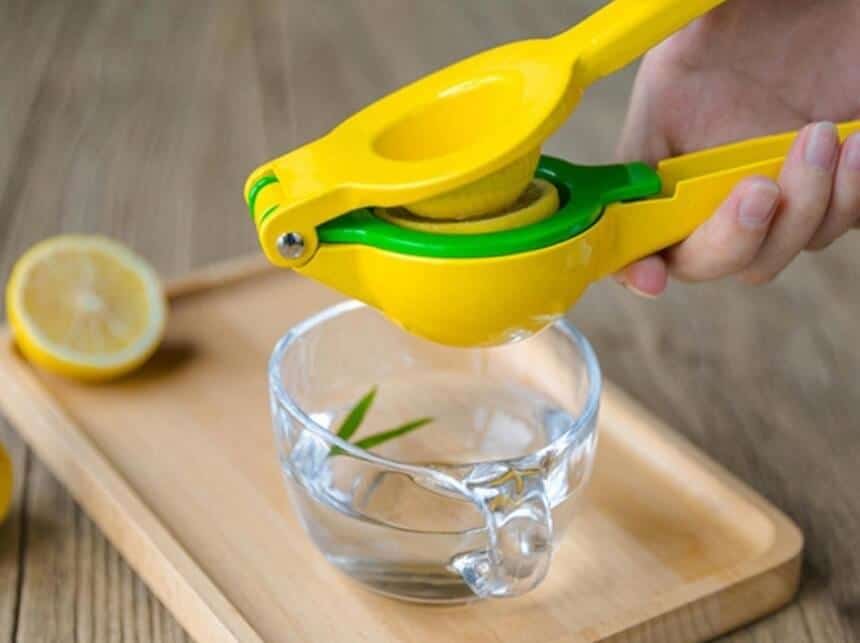
In the past, some of the best citrus squeezers were literally regarded as works of art. A prime example would be the “Juicy Salif” which was a design created by Phillipe Starck as a piece of art back in 1990. This citrus squeezer is regarded as a pinnacle of industrial design and this piece even went on display in the Museum of Modern Art in New York. What made this citrus squeezer special? Well it was made from polished and cast aluminum by an Italian design company and it was a fully functioning juice squeezer.
As you might imagine, we all cannot afford to buy a “Juicy Salif” but there are many juice squeezers on the market that work well. Because of the lever action of many modern citrus squeezers it is possible for kids and those with less strength to operate them easily. In fact, these types of juicers work better than the traditional juice squeezer where you hold the fruit half down as you twist it to extract the juice. These models tend to slip around on the countertop and it’s easy to slip and hurt your hand or wrist.
A steam juicer is not usually found in a home but if you want to extract juice from soft fruits or berries they are a great option. Many people use models such as the Cook N Home, 28cm 11-Quart Stainless Steel Fruit Juicer Steamer Multipot to help them when they need to preserve large quantities of harvested food. These types of juicers use steam to heat the fruit gently. This releases the juice and then it’s collected in a vessel that can be accessed through a hose. Steam juicer users typically store the collected juice in sterile bottles and it can be stored a long time with no need for refrigeration. The entire process is safe and easy but a steam juicer can become very hot during normal operations. If you like it’s easy to add pectin or sugar to create a juice preserve with a very long shelf life. This is a very specialized type of juicer but if you have access to a lot of berries it may make good sense.
As you can see there are many types of juicers on the market and it can be hard to choose which one you need to meet your needs. Hopefully we’ve given you some insight into the common and not so common juicers on the market today. It’s hard to make a recommendation on which juicer to buy, but if you have the budget it’s always a great idea to invest in the best model that you can afford. Some of the best juicers offer a generous 10 year warranty which can give you peace of mind later.
In summary, citrus juicers offer a quick, cheap and easy way to extract juice from citrus fruit. A centrifugal juicer is affordable but the quality of the juice is compromised during the extraction. A masticating juicer will cost a little more but it will produce high quality juice if you have the patience to wait. A twin-gear juicer is a great option if you’re interested in juicing leafy greens, wheatgrass and harder fruits but they are a more expensive option. So, you can find a juicer to fit your budget and requirements.




